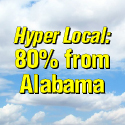Respecting the Power of Severe Storms from Space via GOES-East
NEW: NOAA’s #GOES16 (#GOESEast) gives this impressive view of severe #storms moving across southwest #Kansas on May 2, 2018. #kswx pic.twitter.com/MGwpdP6vjT
— NOAA Satellites PA (@NOAASatellitePA) May 2, 2018
A very important aspect of severe weather which is quite often overlooked is the impact of how modern satellite imager observations have revolutionized the ways in which scientists study, analyze, and forecast both current and past severe weather events.
There is no debate across the atmospheric science forecasting and research communities that GOES-East satellite imagery has completely “changed the game” in terms of how meteorological forecasters and/or researchers analyze and study the atmosphere. More specifically, the GOES-East Advanced Baseline Imager (ABI) 16-channel platform facilitates incredibly high-resolution analyses of storms on very small scales. One such example can be found with the GOES-East 1-minute visible satellite imagery on 2 May 2018 as storms fired up across many parts of Kansas and also across northwest Oklahoma. In the aforementioned 1-minute visible satellite imagery attached above, you can see how there appears to be a “bubbling” phenomena occurring near the center of the cloud deck associated with the blossoming convective storm complex.
This “bubbling” effect is a visual manifestation of what are known as “overshooting tops.” Overshooting tops are an indication of the fact that there is a particularly intense region of a given thunderstorm wherein the updraft is so strong that it breaks through the upper-most part of the thunderstorm. This point at which the updraft breaks through the top of the given cloud deck is what is visually observed as the “overshooting top” part of the thunderstorm. Therefore, it goes without saying that when severe thunderstorms develop these “overshooting tops” features, that is not a time that you want to be under or in the path of such a storm since it would have that much of a greater potential to develop heavier rainfall and even hail at times.
To learn more about other interesting stories pertaining to weather observations, be sure to click here!
AlabamaWX is pleased to partner with the Global Weather and Climate Center team for outstanding posts about our atmosphere. Visit them at https://www.globalweatherclimatecenter.com for more great information!
Category: Partner News Stories
















